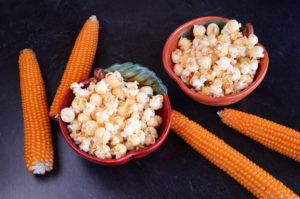
Homemade baked kettle corn is delicious.
History of Popcorn
Have you considered growing popcorn in your garden? Homegrown popcorn is easy to grow and has a superior flavor over store-bought popcorn. Popcorn is native to the Americas; probably one of the oldest snacks, Native Americans showed the English how to pop popcorn in the 16th century, and evidence shows that popcorn was grown thousands of years ago in Peru and Mexico. According to the Popcorn Institute, today Americans consume 14 billion quarts of popcorn annually, it is a universal snack enjoyed by people of all ages.
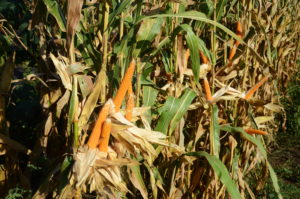
It is to grow an abundant popcorn crop.
Kernel Types and Colors
Popcorn has two basic kernel types one is round called mushroom and pops into a round ball the other has a kernel that is elongated and pops into a butterfly shape. Popcorn varieties come in colors of yellow, white, blue, red and rainbow. Yellow, white, and blue are the most productive, growing large 6 to 9-inch ears with lots of kernels. The unique varieties of red and rainbow produce much smaller ears and are often used for ornamental purposes. You can, of course, pop all of these varieties. Rainbow popcorn shells a small kernel that is just delicious when popped, the little crunchy morsels are a delight to eat.
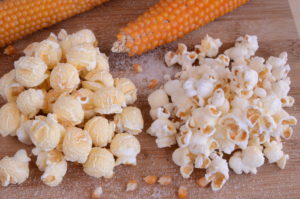
Two types of popcorn kernels one is shaped like a round ball and the other splits open like a butterfly.
Growing Popcorn
Plant popcorn in the spring after the risk of frost has subsided. Plant in multiple rows for better pollination, start by hoeing a small 3 to 4-inch deep trench about 3 inches wide, spacing the trenches about 18 inches apart, or father if you need additional room for your tiller to go through. Lay seeds in the trench about 5 inches apart and cover with dirt. Popcorn will germinate in about 10-14 days. When plants are about 5 inches tall, thin them by pulling them out, leaving one plant for every 8 inches. Popcorn does not need special fertilizer; however, mixing in a little manure or composting vegetable clippings into the soil is advantageous.
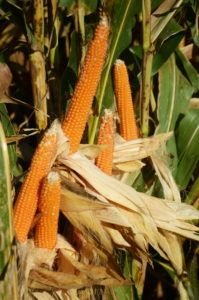
Popcorn ready to be harvested.
Popcorn and sweetcorn should be planted apart from each other to avoid cross-pollination. However, they can be planted next to each other if they are planted at the same time. Popcorn has a longer growing season and normally will tassel later than sweetcorn, if they tassel at different times they will not cross-pollinate. Popcorn is pretty easy to care for; just do the basics keep the weeds out and water if your soil is extra dry. It gets easier to care for once reaches three feet tall because the long leaves naturally shade the ground preventing most weeds from growing.
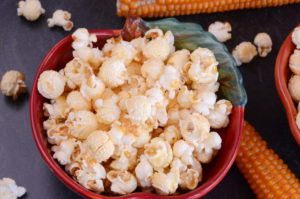
Tasty Homegrown Popcorn!
Harvest
Harvest popcorn when the husks are yellow and completely dry, usually that is late September here in the Midwest. Once the ears have been picked, and husks removed, store ears for additional drying in shallow containers about two ears deep. After one week shell a few kernels off and do a test pop, if the corn pops at 95% or better then it is ready to be shelled and stored, if not give it a few more days and do another test pop. Once you have all of it shelled, take the shelled corn outside and pour it back and forth between large bowls to eliminate the fuzzy flakes that come off the cob when the corn is shelled. Place shelled corn in airtight containers and store in a cool, dry place. Popcorn can store well for two years. You can place a couple bay leaves to each container to ward off pests.

Antique corn sheller valuable help in shelling popcorn.
Farmers Market
Growing popcorn for farmers market is an excellent way to add variety to your offering. You can grow the rainbow and red varieties for fall decorations and grow the yellow, white, or blue for eating. Selling the blue popcorn will undoubtedly draw attention for its unique color and with the long shelf life; popcorn can be sold at fall, winter and spring markets.
Baked Kettle Corn
Make this scrumptious treat without all the work of stove top kettle corn. Baking kettle corn is a super easy way to make this delightful crunchy snack. It has all the sweet, crunchy flavor of on stovetop version, but there is no risk of burning it and no sticky pan to clean up, thanks to the use of parchment paper. Plus, it is very inexpensive to make at home, with a few simple ingredients. It turns out perfect every time and disappears fast. It can easily be made for farmers markets; they will never know that you made it in the oven.

Baked Kettle Corn
Recipe
Baked Kettle Corn
1/3 cup corn syrup
½ cup sugar
1 tablespoon water
1½ tablespoons butter
½ teaspoon vanilla
¼ teaspoon salt
10 cups plain popped popcorn
Add corn syrup, sugar, and water, to saucepan and heat on medium heat. Stir and continue cooking until sugar is dissolved and bring mixture to a light boil, cook for two additional minutes.
Add vanilla, butter, and salt to saucepan bring back to a light boil for an additional 3-4 minutes.
Pour sugar mixture over popcorn and mix well in large bowl. Pour popcorn sugar mixture on to parchment paper on a large cookie sheet and spread to two kernels deep and place in preheated 275-degree oven.
Bake 25 minutes remove from oven and let cool, as it cools break it apart with a large spoon. Once it is cooled, it is ready to serve or store in air-tight container.
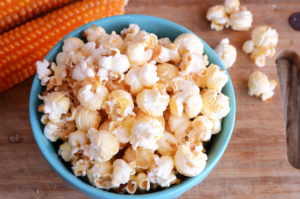
Scrumptious Tasting Kettle Corn.










